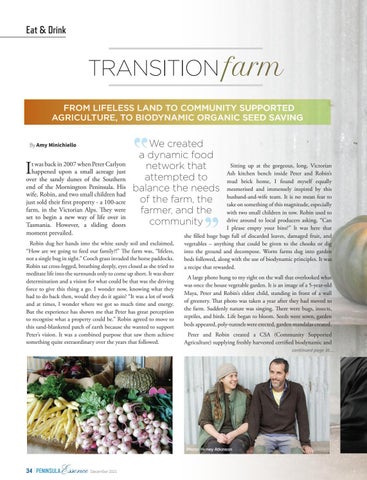Eat & Drink
TRANSITION farm FROM LIFELESS LAND TO COMMUNITY SUPPORTED AGRICULTURE, TO BIODYNAMIC ORGANIC SEED SAVING By Amy Minichiello
I
t was back in 2007 when Peter Carlyon happened upon a small acreage just over the sandy dunes of the Southern end of the Mornington Peninsula. His wife, Robin, and two small children had just sold their first property - a 100-acre farm, in the Victorian Alps. They were set to begin a new way of life over in Tasmania. However, a sliding doors moment prevailed.
We created a dynamic food network that attempted to balance the needs of the farm, the farmer, and the community
Robin dug her hands into the white sandy soil and exclaimed, “How are we going to feed our family?!” The farm was, “lifeless, not a single bug in sight.” Cooch grass invaded the horse paddocks. Robin sat cross-legged, breathing deeply, eyes closed as she tried to meditate life into the surrounds only to come up short. It was sheer determination and a vision for what could be that was the driving force to give this thing a go. I wonder now, knowing what they had to do back then, would they do it again? “It was a lot of work and at times, I wonder where we got so much time and energy. But the experience has shown me that Peter has great perception to recognise what a property could be.” Robin agreed to move to this sand-blanketed patch of earth because she wanted to support Peter’s vision. It was a combined purpose that saw them achieve something quite extraordinary over the years that followed.
Sitting up at the gorgeous, long, Victorian Ash kitchen bench inside Peter and Robin’s mud brick home, I found myself equally mesmerised and immensely inspired by this husband-and-wife team. It is no mean feat to take on something of this magnitude, especially with two small children in tow. Robin used to drive around to local producers asking, “Can I please empty your bins?” It was here that she filled huge bags full of discarded leaves, damaged fruit, and vegetables – anything that could be given to the chooks or dig into the ground and decompose. Worm farms dug into garden beds followed, along with the use of biodynamic principles. It was a recipe that rewarded. A large photo hung to my right on the wall that overlooked what was once the house vegetable garden. It is an image of a 5-year-old Maya, Peter and Robin’s eldest child, standing in front of a wall of greenery. That photo was taken a year after they had moved to the farm. Suddenly nature was singing. There were bugs, insects, reptiles, and birds. Life began to bloom. Seeds were sown, garden beds appeared, poly-tunnels were erected, garden mandalas created. Peter and Robin created a CSA (Community Supported Agriculture) supplying freshly harvested certified biodynamic and continued page 36...
Photo: Honey Atkinson
E ssence
34 | PENINSULA
December 2021
